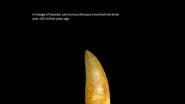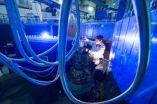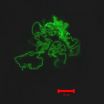(Press-News.org) Quantifying and transforming the history of culture into visual representation isn't easy. There are thousands of individual stories across millennia to consider, and some historical conditions are nearly impossible to measure.
Addressing this challenge, Dr. Maximilian Schich, associate professor of arts and technology at The University of Texas at Dallas, has brought together a team of network and complexity scientists to create and quantify a big picture of European and North American cultural history.
Schich, an art historian who works under the umbrella of the University's Arts and Technology (ATEC) Program, has reconstructed the migration and mobility patterns of more than 150,000 notable individuals over a time span of two thousand years. By connecting the birth and death locations of each individual, Schich and his team have made progress in our understanding of large-scale cultural dynamics.
Schich's research is detailed in the article "A Network Framework of Cultural History," published Aug. 1 in the journal Science.
"The study draws a surprisingly comprehensive picture of European and North American cultural interaction that can't be otherwise achieved without consulting vast amounts of literature or combing discrete datasets," Schich said. "This study functions like a macro-scope, where quantitative and qualitative inquiry complement each other."
Quantitative analysis involves objective, measureable data, while qualitative inquiry relies on subjective or "apparent" qualities.
Schich and his colleagues collected the birth and death data from three databases to track migration networks within and out of Europe and North America, revealing a pattern of geographical birth sources and death attractors.
A key finding in the study, Schich says, is that non-intuitive fundamental patterns, including the so-called "laws of migration," emerge from large numbers of specific events. The team also found evidence for massive fluctuations on a level of single specific locations.
"In practice, this means that cultural history is both an event discipline, where qualitative inquiry focuses on the specific, and a law discipline, where quantification helps to understand general patterns," Schich said.
Other findings show that despite the dependence of the arts on money, cultural centers and economic centers do not always coincide, and that the population size of a location does not necessarily point to its cultural attractiveness.
"In fact, outliers with outstanding cultural attraction, such as Hollywood, Calif., where we find 10 times more notable deaths as births, are found at all sizes, from villages to metroplexes," Schich said.
In addition, the median physical distance between birth and death locations changed very little between the 14th and 21st centuries, from about 214 kilometers (133 miles) to about 382 km (237 miles), respectively.
"There is really no average or typical cultural center," Schich added. "As a consequence, cultural historians really need quantification to complement their intuition based on qualitative inquiry. On the other hand, our results also send a message to complexity scientists. The massive fluctuations we find mean that qualitative inquiry has to complement quantification in order to fully understand the dynamics of cultural migration."
Schich said the topic of art and cultural history is an uncommon topic for papers in journals such as Science.
"A large amount of multidisciplinary expertise was necessary to arrive at the results we found," Schich said. "The paper relies on the fields of art history, complex networks, complexity science, computational sociology, human mobility, information design, physics and some inspiration from systems biology."
While the research that made the paper possible began in Boston and was continued in Zurich, Switzerland, Schich finished his project in Texas.
"The ATEC program at UT Dallas provides an environment where it is possible and encouraged to transcend disciplinary boundaries to understand culture as a complex system. This paper illustrates perfectly the type of work that is taking place in my Cultural Science Lab," Schich added.
INFORMATION:
An art historian by training, Schich is also a founding member of the new Edith O'Donnell Institute of Art History at UT Dallas, where he plans to continue to merge data science, complex networks and art history to bring both quantitative and qualitative inquiry together.
Researchers involved in the study came from the groups of Dirk Helbing at ETH Zurich, the Swiss Federal Institute of Technology and Albert-László Barabási at Northeastern University. Current affiliations of the team include the following institutions: Central European University in Budapest; Harvard Medical School; IBM Research; Indiana University; Ludwig-Maximilians-University in Munich; and The University of Miami. Data was collected from Freebase.com, the Allgemeines Künstlerlexikon, the Getty Union List of Artist Names and the Winckelmann Corpus.
The research was funded by the German Research Foundation, the European Research Council and UT Dallas.
Multidisciplinary study reveals big story of cultural migration
2014-07-31
ELSE PRESS RELEASES FROM THIS DATE:
Shrinking dinosaurs evolved into flying birds
2014-07-31
VIDEO:
This movie is an animated version of how birds arose from a very special lineage of evolving dinosaurs.
Click here for more information.
A new study involving scientists from the University of Southampton has revealed how massive, meat-eating, ground-dwelling dinosaurs evolved into agile flying birds: they just kept shrinking and shrinking, for over 50 million years.
Today, in the journal Science, the researchers present a detailed family tree of dinosaurs and their ...
Innovative 'genotype first' approach uncovers protective factor for heart disease
2014-07-31
Cambridge, MA. Thurs. July 31, 2014 — Extensive sequencing of DNA from thousands of individuals in Finland has unearthed scores of mutations that destroy gene function and are found at unusually high frequencies. Among these are two mutations in a gene called LPA that may reduce a person's risk of heart disease. These findings are an exciting proof-of-concept for a new "genotype first" approach to identifying rare genetic variants associated with, or protecting from, disease followed by extensive medical review of carriers. The new study by researchers from the Broad Institute, ...
A mathematical theory proposed by Alan Turing in 1952 can explain the formation of fingers
2014-07-31
Alan Turing, the British mathematician (1912-1954), is famous for a number of breakthroughs, which altered the course of the 20th century. In 1936 he published a paper, which laid the foundation of computer science, providing the first formal concept of a computer algorithm. He next played a pivotal role in the Second World War, designing the machines which cracked the German military codes, enabling the Allies to defeat the Nazis in several crucial battles. And in the late 1940's he turned his attention to artificial intelligence and proposed a challenge, now called the ...
Nanostructured metal-oxide catalyst efficiently converts CO2 to methanol
2014-07-31
UPTON, NY-Scientists at the U.S. Department of Energy's (DOE) Brookhaven National Laboratory have discovered a new catalytic system for converting carbon dioxide (CO2) to methanol-a key commodity used to create a wide range of industrial chemicals and fuels. With significantly higher activity than other catalysts now in use, the new system could make it easier to get normally unreactive CO2 to participate in these reactions.
"Developing an effective catalyst for synthesizing methanol from CO2 could greatly expand the use of this abundant gas as an economical feedstock," ...
Refocusing research into high-temperature superconductors
2014-07-31
Below a specific transition temperature superconductors transmit electrical current nearly loss-free. For the best of the so-called high-temperature superconductors, this temperature lies around -180 °C – a temperature that can be achieved by cooling with liquid nitrogen.
The location of atomic nuclei and binding electrons in a material is determined by its crystal structure. However, electrons additionally have an electromagnetic angular momentum, referred to as spin. When many spins become coupled in a material, electromagnetic disturbances with a preferential orientation ...
Study finds benefits to burning Flint Hills prairie in fall and winter
2014-07-31
MANHATTAN — Kansas State University researchers have completed a 20-year study that looks at the consequences of burning Flint Hills prairie at different times of the year. It finds that burning outside of the current late spring time frame has no measurable negative consequences for the prairie and, in fact, may have multiple benefits.
The study was conducted by Gene Towne, research associate and the Konza Prairie Biological Station fire chief, and Joseph Craine, research assistant professor, both in the Division of Biology. They recently published the study, "Ecological ...
Fermi satellite detects gamma-rays from exploding novae
2014-07-31
TEMPE, Ariz. - The Universe is home to a variety of exotic objects and beautiful phenomena, some of which can generate almost inconceivable amounts of energy. ASU Regents' Professor Sumner Starrfield is part of a team that used the Large Area Telescope (LAT) onboard NASA's Fermi Gamma-ray Space Telescope satellite to discover very high energy gamma rays (the most energetic form of light) being emitted by an exploding star. The surprising discovery dispels the long-held idea that classical nova explosions are not powerful enough to produce such high-energy radiation.
In ...
NASA sees Genevieve squeezed between 3 tropical systems
2014-07-31
The resurrected Tropical Depression Genevieve appears squeezed between three other developing areas of low pressure. Satellite data from NOAA and NASA continue to show a lot of tropical activity in the Eastern and Central Pacific Oceans on July 31.
NASA/NOAA's GOES Project at the NASA Goddard Space Flight Center in Greenbelt, Maryland has been kept busy, providing visible and infrared satellite imagery of the Eastern and Central Pacific Oceans. The project uses data from NOAA's GOES-West and GOES-East satellites to create images and animations. All four systems were captured ...
CU Denver study links self-identified ethnic labels to cultural values
2014-07-31
DENVER (July 31, 2014) – A recently released study by a researcher at the University of Colorado Denver and published in the Journal of Humanistic Counseling explores why people of Latin American descent self-identify using terms like Latina/o, Hispanic, and Chicana/o. Carlos Hipolito-Delgado, an associate professor in the School of Education & Human Development at the University of Colorado Denver, found a difference between preferred ethnic labels and how a person identifies with their cultural heritage and United States values.
An expert in ethnic identity development, ...
Carnegie Mellon chemists create nanofibers using unprecedented new method
2014-07-31
PITTSBURGH—Researchers from Carnegie Mellon University have developed a novel method for creating self-assembled protein/polymer nanostructures that are reminiscent of fibers found in living cells. The work offers a promising new way to fabricate materials for drug delivery and tissue engineering applications. The findings were published in the July 28 issue of Angewandte Chemie International Edition.
"We have demonstrated that, by adding flexible linkers to protein molecules, we can form completely new types of aggregates. These aggregates can act as a structural material ...






